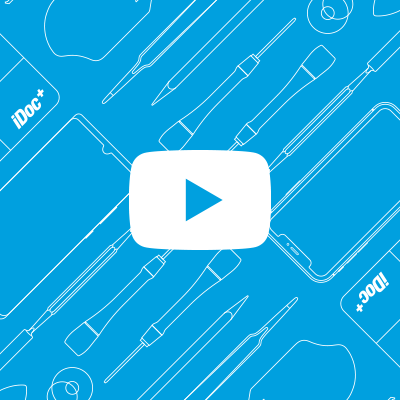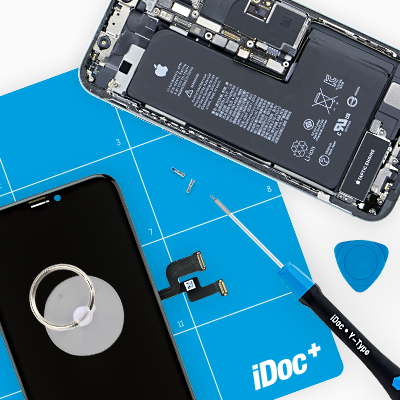Replace your old, damaged rear case with a new one.
In this guide, we show you how to replace a defective back cover for your iPhone 8 Plus on your own. This repair can help if your back cover is warped or scratched, or you want a new color for your iPhone.
We show the replacement of the entire frame and rear glass housing. All parts are removed from the damaged case and installed into the new backcover.
Required tools
-
Tool for prying out batteries
Tool for prying out batteries
You have to use a very stable tool to pry out the battery. At the same time, it has to be flat enough to insert below the battery.
from €10.99 on Amazon -
Heat gun
Heat gun
You can use a heat gun to heat parts that are glued on so they’re easier to remove. In most cases, you can also use a hairdryer.
from €15.99 on Amazon -
For storing screws
For storing screws
We recommend storing your screws so you don’t mix up the various screws and small parts.
from €10.99 on Amazon -
Pick Set
Pick Set
You need a flat but stable tool such as a pick to pry out parts that are glued in place.
from €14.99 on Amazon -
Steel Laboratory Spatula
Steel Laboratory Spatula
You need a flat and sturdy prying tool to disconnect glued parts.
on Amazon -
Pentalobe PL1 screwdriver
Pentalobe PL1 screwdriver
You need the right screwdriver for removing pentalobe PL1 screws.
on Amazon -
Phillips PH00 screwdriver
Phillips PH00 screwdriver
You need the right screwdriver for removing PH00 screws.
from €10.84 on Amazon - Y-type Y000 screwdriver
Steps
49 Steps
Getting started with the repair of your iPhone 8 Plus
If you get stuck or have questions, you can post a comment. We’d be happy to help.
-
Switching off your device
-
Removing the enclosure screws
-
Lifting the display
- Put your iPhone 8 Plus on a soft, clean surface to avoid scratching the back.
- To lift the front panel, you need a suction cup, a hard plastic pick and a heat gun. If the screen is severely cracked, cover all of it with packing tape before you continue.
- The screen is glued to the frame. Use a heat gun to heat the outer edges of the display to about 60°C (140°F).
- Place the suction cup over the Home button (if possible) or next to it. While lifting the screen with the suction cup, insert the hard plastic pick between the aluminum frame and the display frame and then press down the aluminum frame. Because the display is glued on, you have to slide the pick all around the iPhone between the aluminum frame and the display frame. Don’t insert the pick too far on the side of the Sleep/Wake button, because this could damage the display's flex cables.
- Now use the pick to lever the display, so the tabs come out of the aluminum frame. Then you can unfold the display to the side.
- Lean the display to a stable object to avoid overbending the sensitive flex cables.
If necessary, heat the outer edges of the display a few times. Don’t forget that the flex cables for the display are on the side of the Sleep/Wake button. After being opened, the iPhone 8 loses its warranty for protection against dust and spray water (IP 67 rating).
-
Disconnecting the battery contact
- 2 × 1,2 mm Phillips
- 1 × 1,4 mm Phillips
- 1 × 2,6 mm Phillips
Before starting the repair, disconnect the battery contact to prevent short circuits and avoid accidentally turning on your device during the repair.
- Use a phillips screwdriver (Ph00) to remove the phillips screws. Then take off the cover. Put all the parts in the same section of your magnetic pad.
- Now carefully lift off the battery contact by inserting a plastic spudger slightly below the connector.
-
Disconnecting the display contacts
-
Disconnecting the FaceTime contact
- 1 × 1,1 mm Y-Type
- 1 × 0,9 mm Y-Type
- Use a Y-Type screwdriver (Y000) to remove the two Y-Type screws. Then take off the cover. Put all the parts in the same section of your magnetic pad.
- Using a spudger, carefully disconnect the FaceTime contact from the PCB.
- Now you can take off the display all the way.
-
Removing the iSight camera
- 2 × 1,3 mm Y-Type
- 1 × 2,6 mm Standoff
- 1 × 1,7 mm Phillips
- Remove the two Y-type screws, which fasten the bracket plate for the connectors of the iSight camera and remove the bracket plate.
- Disconnect the camera connectors by inserting the spudger very carefully under the connectors and prying them off.
- Unscrew the two screws from the camera bracket and remove it.
- Use the spudger to push the camera unit out of its frame and take out the camera unit.
The internal thread screw is not magnetic.There are special screwdrivers for removing the internal thread screw, but you can also use a regular, thin slotted screwdriver.
-
Disconnecting the standby/volume connector
-
Removing the plastic bracket
- 1 × 1,2 mm Phillips
- 2 × 1,1 mm Phillips
- 1 × 2,9 mm Phillips
- 2 × 1,0 mm Phillips-Schraube
- First remove the Phillips screws from the plastic bracket. Put the screws in the same box.
- Then remove the bracket.
- There are two more Phillips screws under the bracket, which hold a connection piece in place. Remove these screws.
- Now remove the connection piece.
One of the screws is screwed into the back cover sideways.
-
Removing the Wi-Fi antenna
- 1 × 1,2 mm Phillips
- Antenna Connector
- First disconnect the connector from the board.
- Remove the Phillips screw which goes sideways into the back cover.
- The antenna is lightly glued in place. Use a little hot air to detach the antenna or carefully disconnect it by inserting a steel spatula under the cable.
- Then take out the antenna.
-
Removing the SIM card tray
-
Disconnecting the logic board connectors
-
Removing the logic board
- 1 × 2,5 mm Standoff
- 2 × 1,7 mm Phillips
- 1 × 2,2 mm Standoff
- 1 × 2,1 mm Standoff
- Unscrew all screws that hold the logic board in place. You can unscrew the internal thread screws using a special screwdriver or a regular, thin slotted screwdriver.
- Now you can carefully remove the logic board by hand.
-
Removing the speaker
- 1 × 1,1 mm Y-Type
- 1 × 3,3 mm Phillips
- 1 × 2,5 mm Phillips
- 2 × 1,2 mm Phillips
- 1 × 2,3 mm Phillips
- Remove the Y-type screw and the two Phillips screws of the silver antenna bracket plate and remove it.
- Carefully disconnect the coaxial antenna flex cable using the spudger.
- Now remove the Phillips screws that hold the speaker in place. The screws have different lengths. Keep the screws ordered, so you don't confuse them when reinstalling the speaker.
- Now you can remove the speaker and the antenna flex cable.
-
Removing the Taptic Engine
-
Removing the battery
The battery is glued to the case with four adhesive strips. The adhesive strips have tabs to pull them out. The tabs are glued to the top and bottom edges of the battery.
- Use tweezers or a spatula to peel off the black tabs. Underneath are the white adhesive strips.
- Now pull out the adhesive strips very slowly. Keep the strips as flat as possible at the level of the iPhone.
- Once all the adhesive strips are off, you can remove the battery.
Firmly hold the battery and iPhone while pulling out the last adhesive strip to prevent the battery from falling out of the device.
When removing the upper adhesive strips, make sure not to damage the standby/volume cable contact.
If one of the adhesive strips tears, you have to pry out the battery carefully using a wide Spudger. Try to bend the battery as little as possible.
-
Removing the barometric vent
-
Removing the Lightning connector
- 2 × 1.0 mm Phillips
- 2 × 2.2 mm Phillips
- 2 × 1.2 mm Phillips
- 1 × 2.4 mm Phillips
- Now remove the different Phillips screws fastening the Lightning connector cable Order the screws on your magnetic pad so you can easily identify them later.
- Heat the ribbon cable and carefully detach it from the frame using the flat end of the spatula. Work carefully and step by step and reheat the flex cable, if it's hard to get off in some places.
- Use the spatula or spudger to loosen the Lightning connector and the two golden microphones.
- Carefully remove the ribbon cable using your fingers or the tweezers.
The Lightning connector’s ribbon cable is strongly glued.
-
Removing the standby/volume cable
- 6 × 2.1 mm Phillips
- 1 × 2.0 mm Phillips
- Unscrew the two bracket plates which attach the flex cable to both sides of the frame. Each bracket plate has three screws.
- Remove the remaining screw on the bracket plate of the flash and take out the bracket plate.
- Heat the flex cable and carefully detach it from the frame using the flat end of the spatula. The flex cable is glued on
- Carefully remove the flex cable using your fingers or the tweezers. Use the spatula or spudger to loosen the flash and the golden ambient microphone.
-
Removing the retaining brackets
-
Removing the guide rail for the iSight camera
-
Removing the standby and volume buttons
-
Removing the charging coil
You have to reuse the wireless charging coil. This part consists of a big sticker with copper coil in it.
If you're throwing away the old back cover, you don't have to worry about the back cover getting scratched. Otherwise, you'd better use a plastictool like theiPlastix, because the paint is right under the coil.Here you see the iPhon 8, but the procedure is just the same for the iPhone 8 Plus.
- The sticker is glued around the edges. So first heat the edges and then run a flat tool around the whole coil.
- Once the edges of the coil are released, slide your tool all the way under the coil.
- It should come out easily. If not, heat again.
-
Preparing the new back cover
- Rubber gasket
- SIM tray pin
Check and compare the new back cover to the old one. You might need to transfer some small plastic holders or foam rubber spacers.
- Attach all required parts (stickers or plastic holders) to the new back cover.
- You might also have to reuse the little plastic pin for the SIM tray into the new back cover.
-
Attach the charging coil / NFC
-
Installing the standby and volume buttons
-
Installing the guide rail for the iSight camera
-
Installing the retaining brackets
-
Installing the standby/volume control cable
- 6 × 2.1 mm Phillips
- 1 × 2.0 mm Phillips
- Now install the standby/volume control cable where it belongs. Make sure the microphone and flash are fitted correctly. Fasten it using the Phillips screws. Make sure the cable is lying flat and not bent.
- After tightening the screws, check how sensitive the buttons are to pressure and adjust the screws as necessary.
- Firmly press the entire cable onto the chassis.
If you changed the color of the back cover, you also have to replace the aluminum rocker switch, which is hooked onto the button.
-
Installing the Lightning connector
- 2 × 1.0 mm Phillips
- 2 × 2.2 mm Phillips
- 2 × 1.2 mm Phillips
- 1 × 2.4 mm Phillips
- Put the Lightning connector’s flex cable back in its original position and press it onto the back cover so it’s lying flat.
- Fasten all screws that hold the Lightning connector in place.Don’t forget the bracket plate.
- Press both microphones back onto the frame.
-
Installing the barometric vent
-
Preparing the battery
- Battery Connector
To correctly position the battery, you can reinstall all parts except for the logic board. You can place the logic board in the back cover without screwing it.
Place the adhesive strips with protective films attached in the device to make sure that they point in the right direction.- Remove the large blue protective film and stick the adhesive strips to the bottom of the battery. Make sure they are straight.
- Turn the battery over and remove the small blue and pink protective films on the tabs.
- Fold the tabs around and stick them to the top of the battery.
- Remove the large pink protective films from the tabs.
When attaching the adhesive strips, leave enough space on both sides to fold over the tabs.
-
Inserting the battery
-
Installing the Taptic Engine
-
Inserting the speaker
- 2 × 1,2 mm Phillips
- 1 × 2,3 mm Phillips
- 1 × 1,1 mm Y-Type
- 1 × 3,3 mm Phillips
- 1 × 2,5 mm Phillips
- Place the speaker back in its original position and press it towards the lower edge of the iPhone.
- Make sure to correctly position the antenna flex cable between the battery and the speaker.
- Now you can fasten the speaker using the Phillips screws.
- Position the coaxial antenna connector over its socket and slowly press down to connect.
- Reinsert the silver plate and fasten it using the Y-type screw and the two Phillips screws.
-
Inserting the logic board
-
Connecting the connectors
-
Inserting the SIM card tray
-
Installing the Wi-Fi antenna
-
Installing the plastic bracket
-
Connecting the standby/volume cable
-
Connecting the iSight camera
-
Attaching a new frame sticker
- To make sure that the new frame sticker will really stick, remove all glue residue and dirt.
- Remove the first protective film layer of the frame sticker.
- Position the frame sticker carefully on one edge and attach it gradually. Make sure the frame sticker is positioned evenly and press it on.
- Remove the remaining layers of film.
Please make sure the frame sticker is positioned correctly. Each corner has a different shape, which you can use for orientation.An iPhone repaired with a frame sticker will be protected against dust and spray water, but it will not be 100% waterproof!
-
Connecting the FaceTime contact
-
Connecting the display
-
Connecting the battery contact
-
Attaching the display
-
Fastening the enclosure screws
-
Setting the time
When the battery is removed from the device, the iPhone loses the time and sets itself to 1:00 a.m. on 1/1/1970. You could have trouble connecting to the cellular network if the time isn’t set.
After a repair, complete the following steps:
- Synchronize your iPhone with iTunes or connect to a WiFi network and wait until the time is set.
The time won’t be set automatically unless you enable this feature in the settings.
Settings > General > Date & Time > Set Automatically - Remove the SIM tray with the SIM card and reinsert it.
- Activate airplane mode on the device and then deactivate airplane mode.
Settings > Airplane Mode
- Synchronize your iPhone with iTunes or connect to a WiFi network and wait until the time is set.
The right tools for your repair
Bewerte unsere Anleitung
Hat dir unsere Anleitung weitergeholfen? Wir sind auf deine Beurteilung gespannt.
Submit ratingBewertung gesendet
Similar guides
You might also be interested in these guides.
You might be interested in





























































































































































































































































































































































































































































